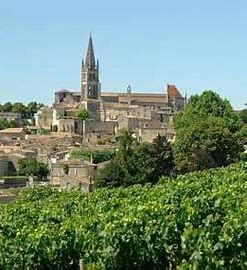The Bordeaux wine region is without doubt one of the most famous and perhaps the most prestigious wine region, not only in France but throughout the world. With 115,000 ha of vines aligned along the Atlantic coast Bordeaux itself produces around half of the major world famous French wines, the so-called “Grands Crus“. The wine district is organized around the Garonne and Dordogne rivers, which flow together and become the river Gironde. Gironde flows then on another 80 km westward before the river empties into the Atlantic Ocean. Grapevines are everywhere and never far from the rivers. On the left side of the Gironde, we find the famous Medoc appellation which probably includes the most famous and most prestigious red wines in the world. Further south and on the other side of the city of Bordeaux, we find Graves, another well-known wine district.
This is where we can appreciate exquisite red wines, but also the sweet Sauternes wines where Château Yquem certainly is the most famous wine house. On the east side of the Garonne River lies the Entre-deux-mer which usually produces price wisely more accessible wines. We continue north to the other side of the Dordogne river and enter again into the prestigious districts, such as Saint-Emilion and Pomerol. In the latter, we find, among others, the invaluable Chateau Petrus. Finally, opposite the Medoc, and east of the river Gironde, we find again the more affordable districts such as Côtes de Blaye and Côtes de Bourg.
The numbers speak for themselves; Bordeaux comprises 57 appellations and more than 4,000 «chateaux». The wineries in the Bordeaux wine region are a bit pretentiously called “castle”, even though the buildings are often just simple houses. 75% of the wines are red, produced mostly north of Bordeaux. The remaining 25% are white wines and produced mainly south-east of Bordeaux. What distinguishes the Bordeaux wines is the great variation of soil type (terroir) and the large number of grape varieties used in the wine production. In the Bordeaux wine region, several different grape varieties are mixed in the same wine. The conditions for maintaining a constant quality and success of each vintage is therefore relatively large, because you can always make up a sort of mediocre grape harvest with a different grape variety that had a better harvest. In Burgundy, for example, this is impossible since only Pinot Noir and Chardonnay are used for the red and the white wines. For the red wines Bordeaux has become known for its oak cask storage and it is also Bordeaux wines that for many have become the rule for how the red wines should taste. Obviously, this inhibits the diversity of the wines. It’s a pitty, since that’s what actually wine enthusiasts are interested in. In Bordeaux primarily Cabernet Sauvignon is used, a grape variety with origins from the Medoc. Merlot and Cabernet Franc are other varieties which are also used on a large scale.
more than 4,000 «chateaux». The wineries in the Bordeaux wine region are a bit pretentiously called “castle”, even though the buildings are often just simple houses. 75% of the wines are red, produced mostly north of Bordeaux. The remaining 25% are white wines and produced mainly south-east of Bordeaux. What distinguishes the Bordeaux wines is the great variation of soil type (terroir) and the large number of grape varieties used in the wine production. In the Bordeaux wine region, several different grape varieties are mixed in the same wine. The conditions for maintaining a constant quality and success of each vintage is therefore relatively large, because you can always make up a sort of mediocre grape harvest with a different grape variety that had a better harvest. In Burgundy, for example, this is impossible since only Pinot Noir and Chardonnay are used for the red and the white wines. For the red wines Bordeaux has become known for its oak cask storage and it is also Bordeaux wines that for many have become the rule for how the red wines should taste. Obviously, this inhibits the diversity of the wines. It’s a pitty, since that’s what actually wine enthusiasts are interested in. In Bordeaux primarily Cabernet Sauvignon is used, a grape variety with origins from the Medoc. Merlot and Cabernet Franc are other varieties which are also used on a large scale.
To understand the classification of the Bordeaux wines is not so easy at first glance. To start with, we have to distinguish ” the ranking” from “the appellations”. Regarding the appellations, there are three major categories. By the way, the rule says that there should be no hierarchy in terms of AOP in France. Nevertheless, the exeption is Bordeaux, there are thus three categories of appellations in ascending order:
1. Generic appellation: it is what we call «Bordeaux» or «Bordeaux supérieur» wines. This category includes all the wines grown in the Bordeaux region, more precisely in the Gironde region
2. Regional appellation: these are wines that come from a more precise area than just the “Gironde”. Graves, Medoc, Côtes de Blaye are some examples.
3. Municipal appellation: some wine growers have felt the need to excel, and man has therefore created appellations referring to the municipality from which the wine comes from. Margaux, Saint-Estèphe, Pauillac, Pomerol or Saint-Emilion are examples of such municipal appellations.
In addition to these three categories of appellations, we must say a few words about the official ranking that was made, ordered by Napoleon III before the World Expo in 1855. The objectivewas to, in 5 different categories, rank the wines produced in the Bordeaux region. All the selected wines except one, Chateau Haut-Brion from Graves, come from the Medoc district, which of course in itself is a major deficiency.
Therefore, to complete the classification from 1855, which just ranked the great wines of the Medoc, the classification of the Graves wines was created in 1959. The difference from the classification of Medoc in 1855, is that there is no internal hierarchy among the wines of the Graves-classification. The classification contains 8 white and 13 red wines. Even Saint-Emilion that was not part of the 1855 classification, has created its own classification which was modified as soon as in 1996. These classifications are today incomplete in many ways. On the one hand, they represent only a few very exclusive wines and do not take into account the wide range of more accessible and very good wines from the Bordeaux wine region. On the other hand, no official ranking has been made between all the different appellations so it can not be said that for example a Pauillac is better than a St. Emilion, or vice versa – it is rather a matter of taste when judged by everyone. Finally, it should be noted that the Pomerols are not even included in any official classification even though we find world famous wine houses here such as Chateau Pétrus.


